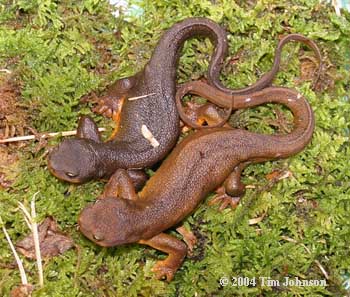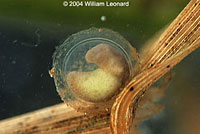Taricha granulosa
Roughskin newt
Taxonomy:
Kingdom: Animalia
Phylum: Chordata
Class: Amphibia
Order: Caudata
Family: Salamandridae
Genus: Taricha
Species: T. granulosa
Subspecies: T.g. mazamae


www.caudata.org www.urodeles.com
Identification:
Rough-skin newts are a stocky, medium-sized lunged salamander with dry granular skin, and no costal grooves. Black, brown, reddish-brown, or light brown above, yellow or orange below. Some populations have dark blotches on the back or the venter. Breeding males develop smooth skin, flattened tail to aid with swimming, swollen vent, and rough nuptial pads on the undersides of the feet to aid in holding onto females during amplexus. Lower eyelids are dark. Irises are yellowish. Larva are pond type, brown with a row of light spots on the sides of the body. Rough-Skinned Newts have a dark brown to tan color dorsally and a yellow to orangish-red color ventrally. Males of this species can attain a size of around 170mm total length while the smaller females average around 140mm total length.
Distribution:
The Rough-skinned newt in the Pacific Northwest, from northern California to British Columbia. In Oregon it is found from the Cascades west to the Pacific Ocean. Occurs from Santa Cruz county north through the north coast ranges and around the northern edge of the great valley south in the Sierra Nevada foothills to near Magalia in Butte County. Ranges north through Oregon and Washington and up the coast of British Columbia to Alaska. Rough-Skinned Newt are rare in Idaho and were probably introduced with only a small populations inhabitating ponds around Moscow, ID.

Habitat:
In most populations, adults migrate seasonally between terrestrial and aquatic habitats. Terrestrial adults are found in a variety of habitats such as coniferous forests, redwood forests, oak-woodland, farmlands, and grassland. Most adults can be found in underground retreats within close proximity of ponds used for breeding. Rough-skinned newts are the most aquatic of the three species of Taricha. Aquatic habitats include lakes, ponds, roadside ditches, and slow-moving portions of streams, but bodies of water lacking surrounding vegetation are avoided. The amount of time spent in aquatic versus terrestrial habitats varies with permanence of the aquatic habitat, elevation, locality, and sex. The length of time spent in aquatic habitats generally differs between the sexes, with males spending more time in the water than females. Furthermore, in northwestern California and western Oregon, adults breeding in permanent lakes and ponds spend more time in aquatic habitats than those occupying temporary bodies of water. At permanent ponds, males spend about 10 mo in the water, whereas females spend about 8 mo. At a few localities in California, Oregon, Washington, and Idaho, permanently aquatic, perennibranchiate individuals of both sexes have been reported, mostly at high elevation sites. In California, adults using streams usually remain aquatic all year unless forced to leave when water flow rises during winter floods.


Behavior:
The natural history of Roughskin Newts varies widely over its range. It is generally terrestrial and can be seen on land during the day. However, some populations have been know to hide in the daylight and at night become active. Newts are often seen moving to other sites during the breeding season. Migration to and from breeding sites varies among populations. Some newts spend the dry summer in moist habitats with adults emerging after the fall rains. In some populations, adults remain in the ponds throughout the summer and migrate back onto land in the fall when the rain starts. Often they will form large populations with thousands of newts in the water. In other populations, males remain in the ponds all year. Adults in have been found in some California streams all year long except during winter flooding.
Roughskin Newt's defense reaction is a swaybacked defense pose with a coiled tail, exposing the bright ventral surface to warn potential predators (shown below). However, their main defense mechanism is poison. Many newts produce toxins to avoid predation, but the toxins of the genus Tarich are particularly potent. The Rough-skinned Newt produces tetrodotoxin in the skin and one thirtieth of the toxin present in an average adult rough-skinned newt is sufficient to kill a healthy adult human. The toxin is generally only toxic if the newt is ingested, although there are reports that some individuals experience skin irritation after contact

Reproduction:
Breeding habitat. Mating occurs in quiet water habitats including ponds, lakes, reservoirs, drainage ditches, and slowly flowing sections of streams. The timing of breeding varies substantially over the range of rough-skinned newts. At low elevation sites in northern California, mating may occur from late December to June, with peak activity in March and April Breeding occurs in winter in western Oregon. At moderate to high elevation lakes in northern California and Oregon, mating occurs during summer and autumn.
Females at a single locality spawning or with eggs in their oviducts from late December to June in northern California. Egg-laying usually occurs in late winter to spring in western Oregon and occurs during June and July at low elevations in British Columbia. Spawning probably occurs in autumn in most montane populations in northern California and Oregon. Rough-skinned newts show a stronger preference for spawning in quiet water habitats than any other species in this genus. Females usually deposit eggs singly onto stems and leaves of submerged plants, usually within a few inches of the water’s surface (shown below). Eggs appear light tan on the top and cream on the bottom and have three envelopes in addition to the vitelline envelope. Oviposition is cyclic, occurring for a few days, followed by a period of non-laying, with this process being repeated at intervals.


Scientific Study:
Just like any other amphibian species, the Rough-skin newt is an indicator to the threat of global warming. This research study looked at the affects of Ultraviolet (UV) radiation on Rough-skin newts (Tasraicha granulosa). The eggs and larvae of certain amphibian species hatch at significantly lower rates when exposed to ambient ultraviolet light. Yet little is known about the sublethal effects of UV radiation. For example, UV radiation may affect specific behaviors of an animal that could alter its ability to survive. Researches exposed Newts to low-level doses of UV in the laboratory and then tested in the field to examine if UV-exposed and control (no UV) newts differed in orientation towards water or in locomotor activity levels. UV-exposed and control newts both exhibited a significant orientation towards water in field tests but there was no significant difference in orientation between treatments. However, UV-exposed newts were significantly more active than control newts. Our results suggest that exposure to short-term low levels of UV radiation alters certain behaviors. Environmentally induced changes in behavior may have significant ecological and evolutionary consequences.
Methods- 84 adult male roughskin newts were collected in Oct. 1996 from the Corvallis Watershed Reservoir in the Oregon Coast Range and transported to Oregon State University. Six newts were placed into each of 14 glass aquaria that were filled with dechlorinated tap water. Newts remained in the water; climbing material was not available in the aquaria. The 14 tanks were placed in a room that was illuminated with artificial UV light. Newts were transported back to the Corvallis Watershed Reservoir after UV exposure to test for differences in activity and (or) orientation between those in the UV-blocking and UV-exposed treatments. Three areas were identified on land that were suitable for completing the tests, each consisting of a large flat sparsely vegetated area. The circles were 30.7, 42.5 and 51.2 m from the shoreline. The most direct path to the water was at a compass direction of 240, 255 and 255 degrees, respectively. An individual newt was placed with their initial position at random with respect to the water, under an an inverted plastic pail in the center of the 6-m diameter circle. After a 30-s acclimation period, the covered was removed by a remote pylley system and recorded: (1) time taken for the newt to start walking, (2) time taken for the newt to leave the circle, and (3) the location (compass direction) where the newt left the circle. Observers were positioned at least 5 m from the outside circle in random positions throughout testing.
Results:Results from the study showed that exposure to relatively short-term but constant levels of UV-B radiation significantly affected at least one locomotor activity pattern in newts. It was suggested that continued exposure to UV-B radiation was stressful to newts. The observed differences in locomotion between UV-exposed and control newts may be proximally related to neuroendocrine stress responses associated with the hypothalamo-pituitary-adrenal axis. In response to stressful conditions, corticotropin-releasing hormone (CRH) is secreted by hypothalamic neurons, which stimulates target neurons in the brain causing behavioral responses such as increased locomotion.
References
Amphibian Species of the World 5.0, an Online Reference, http://research.amnh.org/herpetology/amphibia, Daryl Frost and the American Museum of Natural History.
AmphibiaWeb: Information on amphibian biology and conservation. [web application]. 2007. Berkeley, California: AmphibiaWeb. Available: http://amphibiaweb.org/. (Accessed: Sep 27, 2007).
California Herps: http://www.californiaherps.com/salamanders/pages/t.granulosa.html
Edmund D. Brodie, Jr. Investigations on the Skin Toxin of the Adult Rough-Skinned Newt, Taricha granulosa Copeia, Vol. 1968, No. 2 (Jun. 5, 1968), pp. 307-313
http://www.answers.com/topic/rough-skinned-newt
http://imnh.isu.edu/digitalatlas/bio/amph/urodela/tagr/tagrfram.htm
IUCN, Conservation International, and NatureServe. 2006. Global Amphibian Assessment. www.globalamphibians.org.
Frost, Darrel R. 2007. Amphibian Species of the World: an online reference. Version 5.0 (1 February 2007). Electronic Database accessible at http://research.amnh.org/herpetology/amphibia/index.html. American Museum of Natural History, New York, USA.
Oregon State University. Natural History Discovery Days. http://oregonstate.edu/~arnoldst/NEWT%20WORLD.htm
U.S. Geological Survey URL: http://www.npwrc.usgs.gov/resource/herps/amphibid/species/taricha.htm
Created by: Eric Killoy
Comments (0)
You don't have permission to comment on this page.